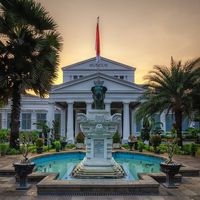National Museum of the Philippines

The National Museum, a Trust of the Government, is an educational, scientific and cultural institution that acquires, documents, preserves, exhibits, and fosters scholarly study and public appreciation of works of art, specimens, and cultural and historical artefacts representative of the unique to the cultural heritage of the Filipino people and the natural history of the Philippines. It is mandated to establish, manage and develop museums comprising the National Museum Complex and the National Planetarium in Manila, as well as regional museums in key locations around the country.
Currently, the National Museum national network comprise 19 regional, branch and site museums throughout the archipelago. The National Museum manages and develops the national reference collections in the areas of cultural heritage (fine arts, anthropology and archaeology) and natural history (botany, zoology,and geology and paleontology), and carries out permanent research programmes in biodiversity, geological history, human origins, pre-historical and historical archaeology, maritime and underwater cultural heritage, ethnology, art history, and moveable and immoveable cultural properties.
Appreciation of the collections and research findings of the Museum, as well as technical and museological skills and knowledge, are disseminated through exhibitions, publications, educational, training, outreach, technical assistance and other public programmes. The National Museum also implements and serves as a regulatory and enforcement agency of the Government with respect to a series of cultural laws, and is responsible for various culturally significant properties, sites and reservations throughout the country.
Similar content
posted on
30 Nov 2011
posted on
15 May 2012
posted on
14 May 2019
posted on
06 Sep 2010



